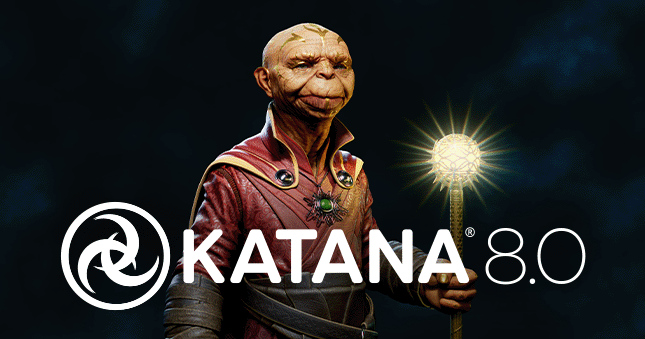Look development
Artist-focused look development UX
Katana ships with the industry's most powerful look development architecture and UX. Artists can create incredible look development on a single complex asset or hundreds of variations, all supported by an architecture that allows look development to continue in parallel to shot production.
- Manage complex material setups - The Network Material Create node was built to create and manage multiple materials—all part of a node graph system designed to perform efficiently with even the most complex shading networks.
- Easy procedural edits - Katana’s Network Material Edit node provides you with the ability to make procedural edits to network materials made in Katana or imported from USD, coupled with an easy-to-use UI which ensures you can see the full network, plus any existing edits.
- Your hub for USD based look development - Katana ships with a native USD/Hydra plugin that allows Katana to author, consume and edit USD Preview Surface materials, displayed in full glory in the HdStorm-powered Hydra viewer.
- Material solo - Easily preview your work and get a better understanding of how every single node impacts the final result with Katana 6.0. The new Material Solo feature enables artists to gain instant visibility over components of their material setups, allowing them to quickly isolate and debug complex material networks. Forget about rewiring your setup and enjoy the functionality of previewing any section, at any time so you can work more efficiently.
- NetworkMaterialEdit Material Interface - Building on the functionality originally introduced in Katana 4.5, the NetworkMaterialEdit Material Interface feature allows artists to easily modify and manage the material interface within the NetworkMaterialEdit node. Users are no longer restricted to working in a linear way and now have more freedom in modifying their setups downstream. The result? Modifications can be made without having the original material at hand and there’s better flexibility whenever working with materials.



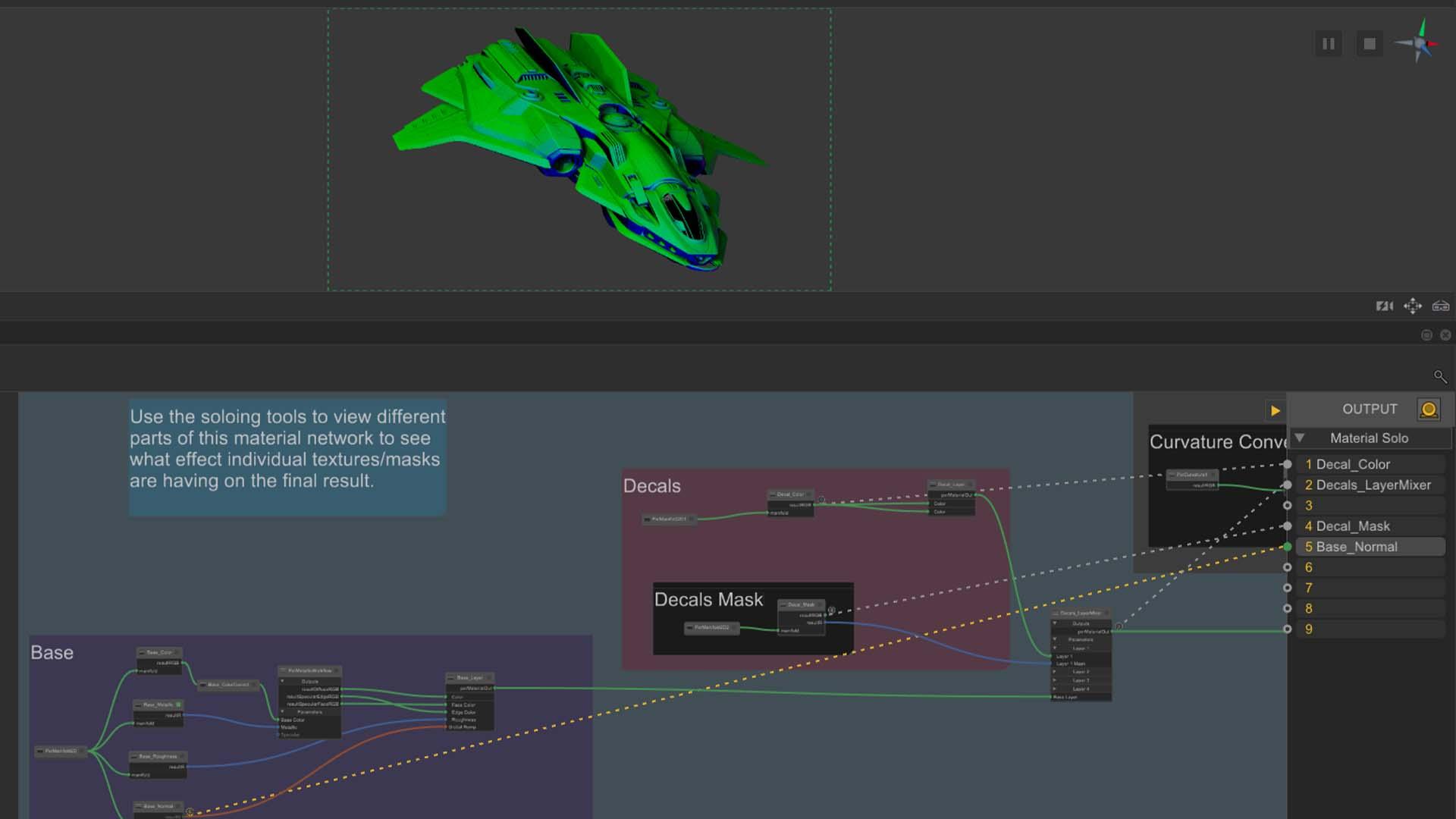

Advanced Look Development Workflows
Katana has several workflows that make it a look development powerhouse for artists, teams and pipelines—from tools that allow senior artists to make look development building blocks that drive consistency of art direction, to tools that allow a single artist to deliver more than anyone could expect.
- Multitasking of look development - Materials can store parameters for the surface, displacement or light shaders for multiple renderer plugins at the same time, empowering you to drive both the look of your viewport and any final render with a single assignment.
- Complexity tamed and shared - Construct Network Materials using a combination of texture maps and renderer procedural nodes in an artist-focused UI. Share nodes between multiple shading networks, and create complex networks with curated controls, exposed for you to adjust without fear of inconsistent art direction.
- Powerful hierarchical procedural workflows - Variations of assets have never been so easy to look develop as when using Katana’s parent and child material toolset, in which all the promoted controls of the parent can be adjusted as procedural overrides on the child material.
- Make look development modular - Simplify complex shading networks for sharing and reuse by putting them inside Katana’s Shading Groups. Here, they can have their inputs and outputs promoted to its surface, shown as custom port connections, with applicable parameters in the parameter interface.

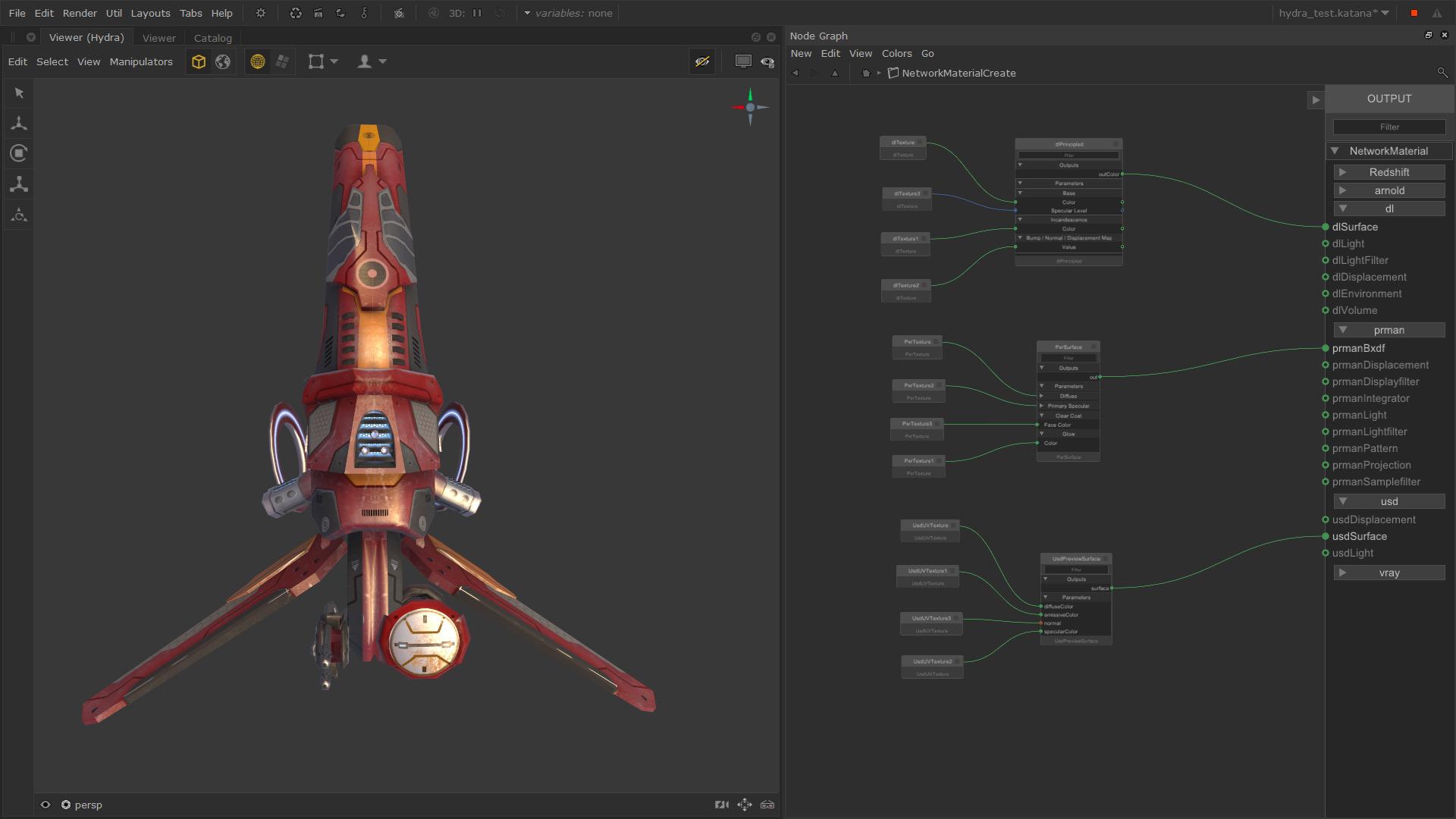

Lighting
Artist-focused Lighting Tools
Katana’s Lighting Tools overhaul the traditional digital lighting experience in a remarkable feat of UI and UX, streamlining creative workflows so artists and teams can directly respond to art direction requests, meaning less time for drudgery, and more time for creating something incredible.
- Precise control - Work directly on top of the image during a live render session with gesture-based controls, optimized for mouse or Wacom products. Katana’s Monitor Layer draws final render quality pixels in the Hydra Viewport. Know exactly what light does what with rich UX feedback, allowing full screen sessions with reduced distractions
- Light at the speed of thought - Create and edit lights by interacting directly with the image and scene objects. Think the same way as a cinematographer in terms of practical light sources, and execute your light choices at the speed of thought for lightning-fast creativity.
- Get closer to your creations - Work directly in Katana’s viewer with a simplified heads-up display to control light properties such as intensity, exposure and color. Use on screen controls to manage your lighting scenarios directly from the viewer and experience power and freedom at your fingertips.
- Gaffer Controls at your fingertips - Do more common tasks directly in the viewer—like renaming, deleting, and adopting lights for editing. Each of these controls is available for any of the available Gaffer Three nodes in the active node graph which are controlled directly from the viewer as well.
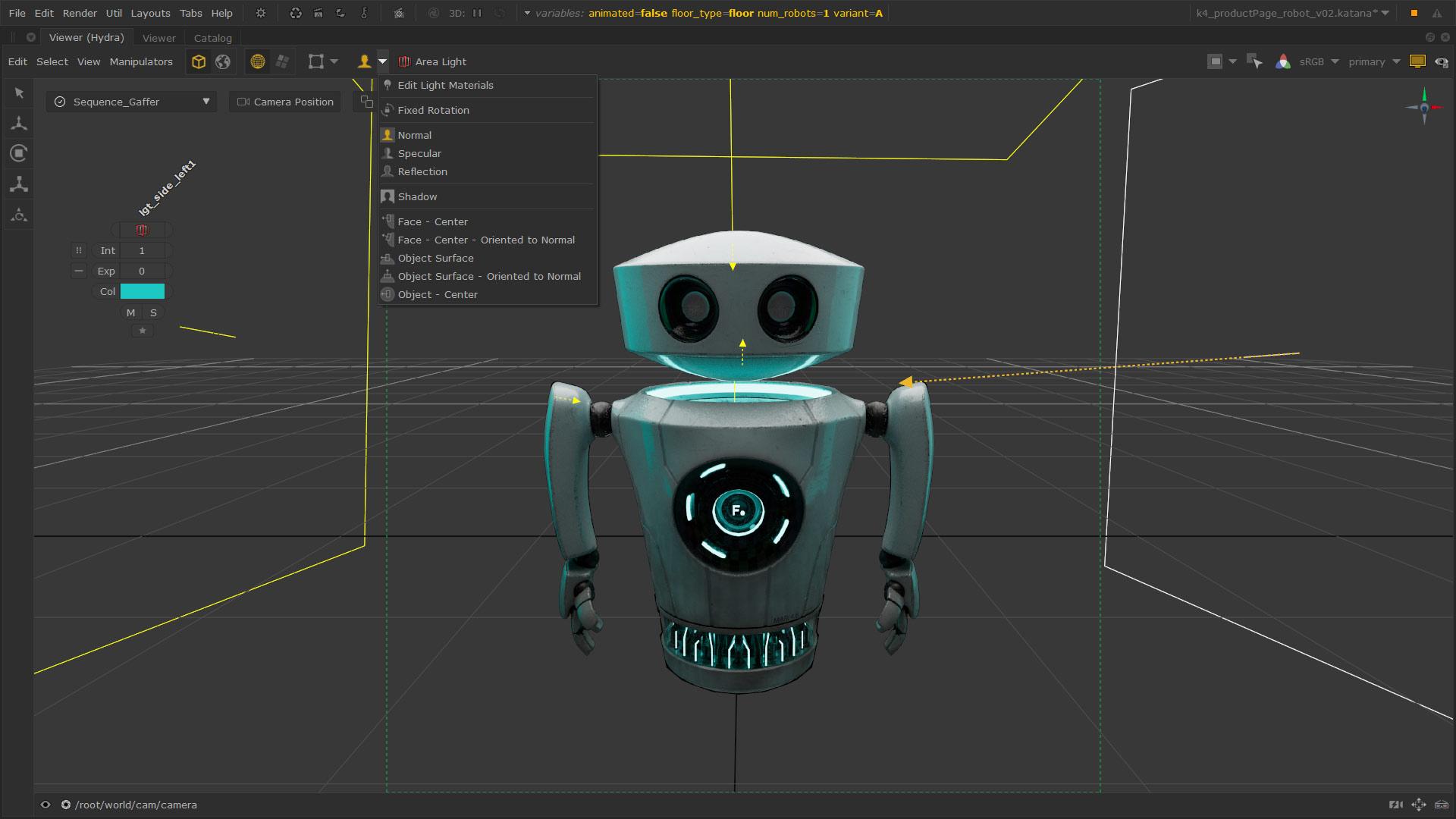


Focused lighting production toolset
Katana’s lighting production toolset is designed to save you time whether you’re working on a single shot or a whole sequence, allowing the least amount of artists to manage the highest volume of high-quality shot production. Deferred loading, procedural workflows, collaborative tools, rich viewer and live rendering feedback all empower artists and teams to do the incredible.
- Procedurally powered sequence-based lighting - Katana’s GafferThree node wraps light creation and editing into a single node, allowing you to interact with individual lights directly or control multiple lights at the same time via the Template Materials, and edit previously created lights with surgical procedural edits.
- World class interactive rendering - Katana communicates all rendering edits as individual changes to a rendering plugin, allowing renderer plugin vendors to access an unrivalled granularity of information. Robust rendering APIs mean never again will a crash occur because of a glitch from the rendering process; instead, you can identify the issue in the rendering and continue where you left off.
- Rich artist feedback - Katana’s highly-configurable UI empowers you to interact with the lights and shadows of Katana’s Hydra Viewport, the rendered image in the Monitor Layer or the Monitor tab. Meanwhile, the Catalog system provides lighting feedback on the full history of your current and past renders.
- Scene data baking: eliminated - Katana talks directly to the renderer during the render process and feeds scene data on demand as it’s needed, eliminating the need to bake it to vendor-specific archive file formats and providing complete control throughout the process.



Artists
UsdLight
Now artists are able to create lights in Katana on a USD stage, which means that scenes no longer need to be converted from Geolib to make them work in the native USD space. This also provides further support for studios who want to run a fully native USD pipeline.

USD in Hydra improvements
USD prims, including new locators for lights and cameras, can now be manipulated in the Hydra viewer, continuing to improve the user experience of artists working natively in USD.
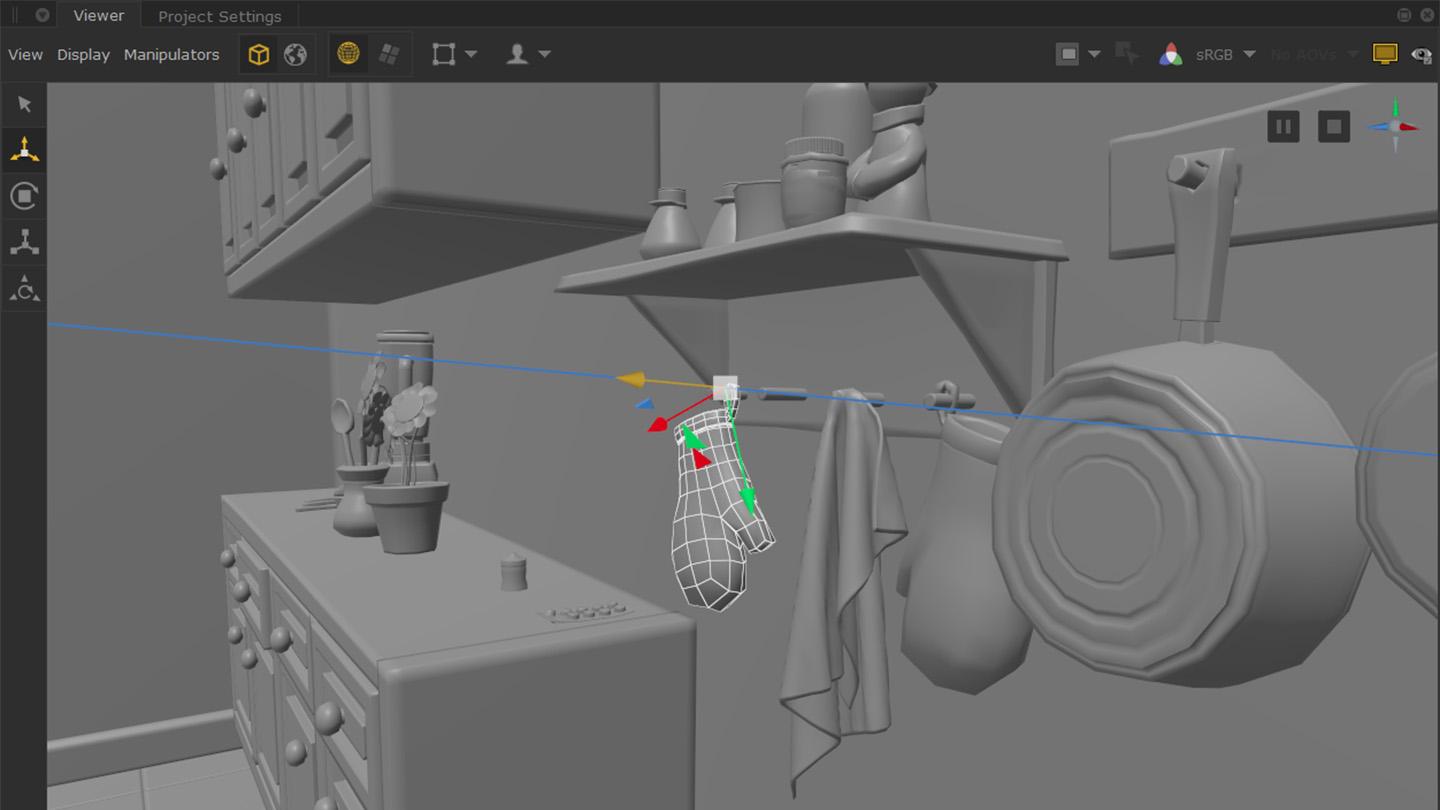
Performance improvement: Traversal optimization
Artists will notice interactivity improvements when larger Node Graphs are being evaluated, particularly when changing a parameter within a node. Scenes now load up to 2.5x faster when compared with Katana 7.0, thanks to Katana’s Node Graph traversal process being largely ported over from Python to C++.
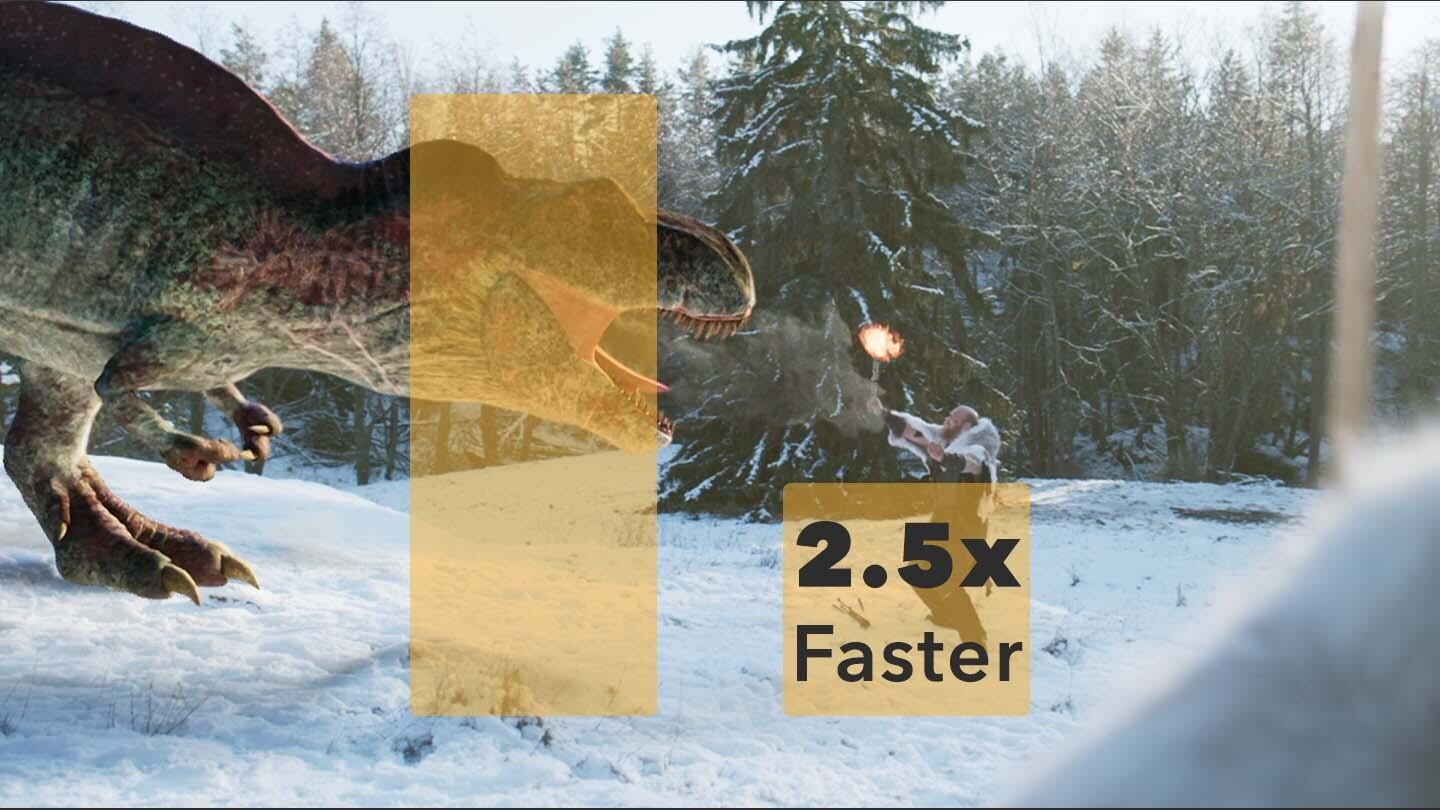
Multi-threaded Live Rendering
Experience speedier interactive updates that are up to twice as fast, with upgraded, muli-threaded Live Rendering. With enhanced Live Rendering and compatibility with Foresight+, you can greatly improve productivity and performance, all without compromise.

Pioneering Foresight Rendering
Katana’s scalable interactive rendering capabilities create truly formidable creative workflows in any pipeline. Simultaneously render multiple images as you work across multiple shots, frames, or assets from within one Katana project file. The additional horsepower of networked machines provide faster renders and scalable feedback, and the added knowledge that you’re making all the right choices.
- Multiple Simultaneous Interactive Rendering - Multitasking made easy: thanks to newly-built APIs, Katana now has the ability to run multiple renders at the same time, empowering you to render images whilst working across shots, assets and tasks in the same file.
- Networked Interactive Rendering - Rendering requires computational power—which is why Networked Interactive Rendering provides the ability for artists to use networked machines other than the one they’re working on to facilitate multiple simultaneous interactive renders for a single Katana session.
- Bespoke render queue system - Katana Queue, a small render queue system, was built to maximise your machine(s) when multitasking thanks to a scalable rendering solution fully controlled by you from a new process control interface called the Katana Queue tab.
- Flexible UX for consuming multiple simultaneous renders - Katana’s Catalog and Monitor tab provides crucial UIs for viewing multiple simultaneous renders. View multiple renders update live with user configurable thumbnails or interact with two images at the same time in detail. Even inspect a render from two different pan and zoom levels at the same time.
- Mass Render Submission - Katana includes an example tool for the submission of a set of renders that power a range of options. This comes in the form of a sample script that creates a simple UI, showing the possible combinations of Render node, frames, and Graph State Variables.
- Foresight+: unrestricted live rendering - Building on Katana’s Foresight capabilities, Foresight+ features additional architectural updates to enable selective changes to be applied only to relevant live renders, whilst allowing artists to work on as many shots as they like from one template. The result: see every change made that influences all of your shots in a sequence, live, inside Katana, without having to wait for tomorrow’s dailies. This ultimately raises the quality of all shots simultaneously with no nasty surprises.


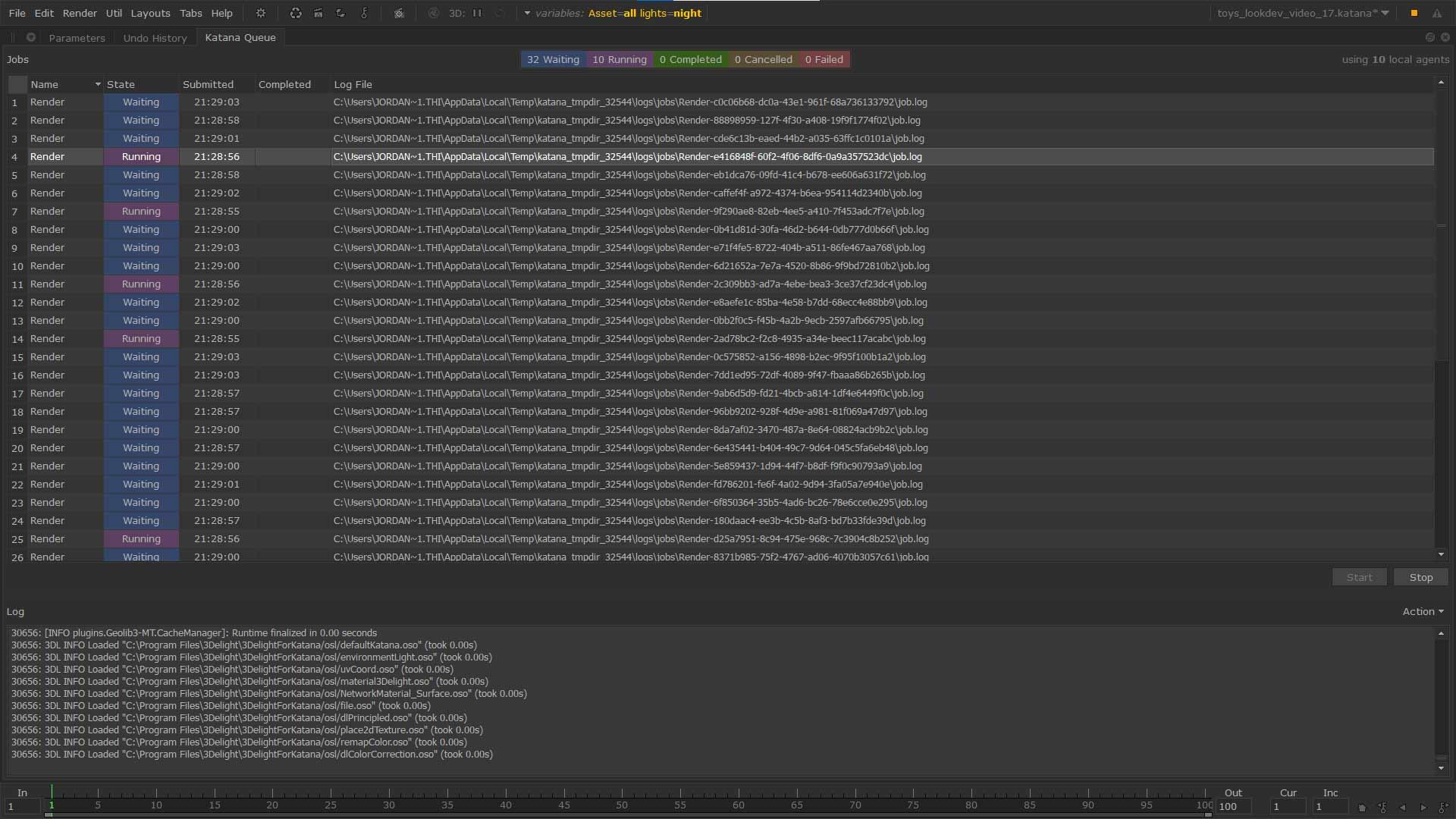


Supercharged powerful viewport
Katana features a modern and powerful viewport driven by the PIXAR USD Hydra technology—perfectly designed to work with modern graphics cards whilst handling massive scale.
- Rich PBR GL feedback - Katana’s Hydra Viewer provides awesome viewer fidelity and performance thanks to a rewrite of the bridge that connects Katana to Hydra and the Hd Storm render delegate, offering a more robust understanding of USD information and a richer viewer experience.
- Monitor Layer - A key component of Katana’s Digital Cinematography workflows, Katana’s Monitor Layer can be used to view the output of the renderer plugin directly in the viewer, and objects can be selected directly from the image using image-based selection tools.



Unlock Katana's power
Katana enables look development and lighting artists to push the limits of what they can do. With new features like the Performance tab, users can spend less time investigating issues to help reach that first pixel quicker.
- Performance Tab - Debug your scenes more effectively with a new Performance tab, enabling you to keep track of the scale of your scenes—this can be the size of the Node Graph itself or time spent against various nodes. Introduced in Katana 6.0, this feature allows users to understand where bottlenecks may lie in the Node Graph with the help of a customizable color-coded Heat map that shows which nodes are taking the most time.

Teams
Seamless collaboration
Creativity is best shared. That’s why Katana is designed for whole look development and lighting teams working in tandem to get to that perfect final render faster through highly efficient workflows, features, nodes and scripts.
- USD debugging tools - Katana 8.0 brings a brand new USD Text View tab which allows artists and TDs to be more informed on what's happening on the USD stage. This new tab is great for both debugging and helping artists to learn USD, and what each node is doing behind the scenes for additional context. Furthermore, error handling has been improved.
- Performance Tab: Python Profiler - The Performance Tab now has a Python Profiler section, providing a simple interface for collecting and displaying Python profiling data of the application. This enables you to understand the most time-consuming scene changes for debugging purposes.
- Powerful node graph workflows - Collaboration and reuse are at the heart of Katana’s look development and lighting time-saving efficiencies. Using the node graph, artists work by defining a series of ordered steps, which can be shared with other team members, or reused for other parts of the project.
- Live Groups - Live Groups let you group and publish parts of the node graph and save them to disk for sharing or reuse. Similar to a referencing system, you can manage versions of these groups, and publish changes to them wherever they are used.
- OpScript - TDs can write custom tools to do anything from simple tasks to complex sets of action without writing a single line of C++. Specific tools packaged as macros via Katana’s OpScript node provide a valuable way for the more technically-savvy to empower artist-focused team members.
- Macros - Macros let you easily package up a set of nodes into a shareable tool, without the need for scripting. You can select which controls to expose, reducing unnecessary complexity and presenting the user with a clear and simple interface.
- SuperTools - SuperTools allow you to create powerful tools with a custom UI that can dynamically create nodes, facilitating complex workflows in a simple user-facing tool. The nodes inside are created and controlled using Python scripts, presented as a single new node with a customizable interface.
- Macros - Macros let you easily package up a set of nodes into a shareable tool, without the need for scripting. You can select which controls to expose, reducing unnecessary complexity and presenting the user with a clear and simple interface.
- LiveShadingGroups - Katana 6.0 extends its look development toolset with the introduction of LiveShadingGroups. With Macros and User Parameters being introduced in Katana 4.5, this feature is another piece of the puzzle and enables users to share and reuse their work seamlessly between projects, assets or other artists. Any changes that are made to the original LiveShadingGroup will automatically be applied to any scenes that contain it, eliminating the need for a manual update when reopened. Start streamlining your workflow by reusing and recycling work.

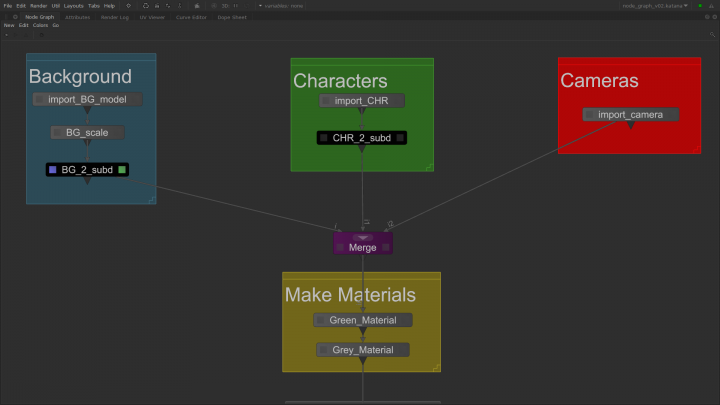

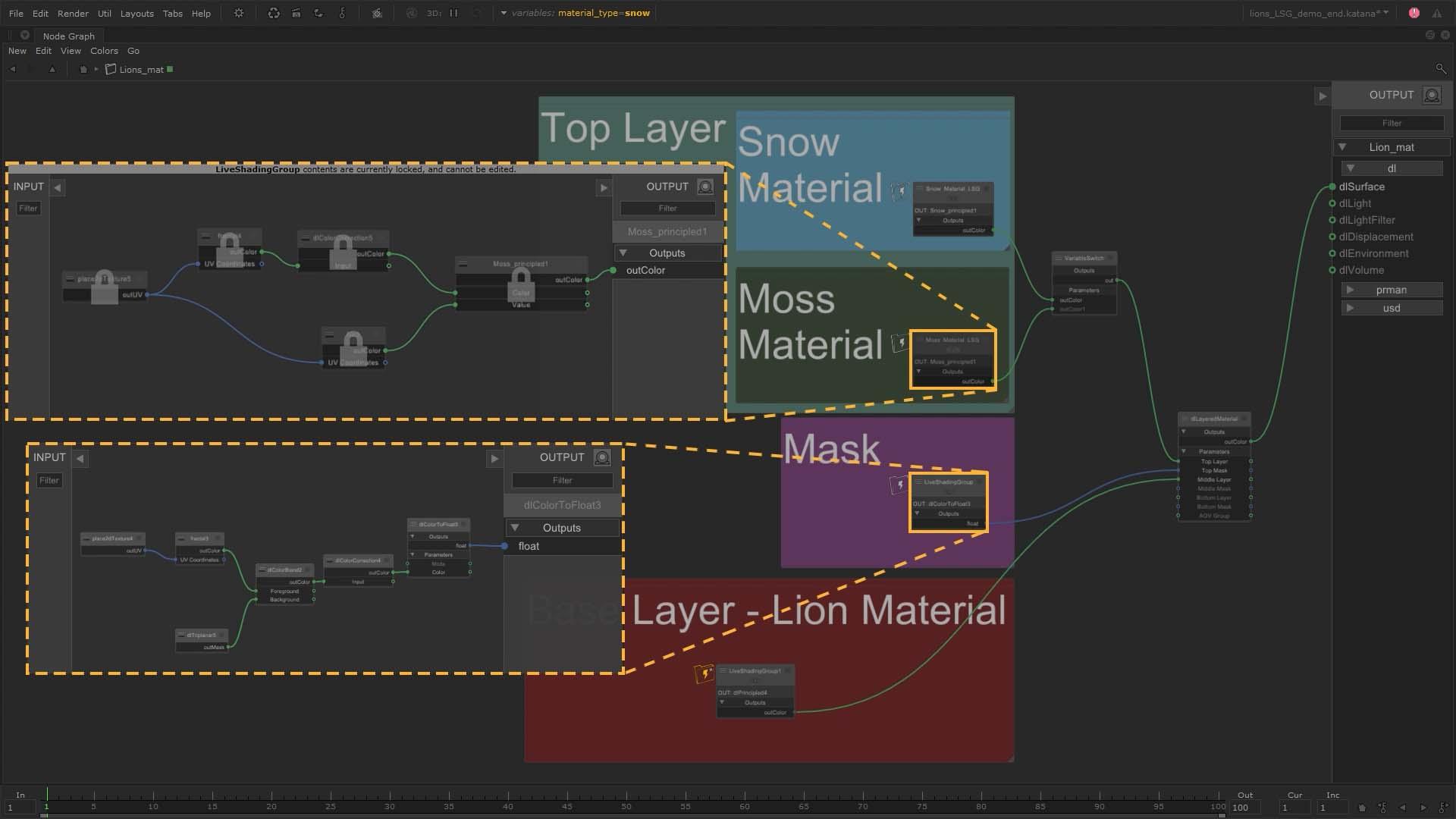
Pipelines
A pipeline polymath
Flexibility, customizability and interoperability are an intrinsic part of Katana’s DNA. Featuring advanced USD technology, an extensive set of APIs and plug-ins, multiple scripting languages and OCIO color management, Katana will soon cement itself as the Swiss Army knife of your pipeline.
- USD scene manipulation - Reduce pipeline friction with USD-native workflows in Katana. Built on the same underlying architecture as Nuke’s new 3D system, Katana 7.0 focuses on building artist-friendly workflows that pair Katana’s strengths in managing complex scenes with native USD’s pipeline flexibility. Expanding on the original USD Katana nodes that enabled the scene description standard to be brought into the tool, we’ve added the framework for native USD manipulation, plus a selection of new nodes, to harness the combined power of USD and Katana.
- OCIO color management - Industry-standard OpenColorIO (OCIO) color management runs through all image-related operations in Katana, so you can work with the confidence that your color spaces are correct. Like Katana, OCIO was developed at Sony Pictures Imageworks.
- A choice of scripting & programming languages - Support for Python, Lua, C and C++, along with powerful libraries like ILM’s Imath, provide great flexibility for any level of pipeline developer. Choose the right language for any given task and get up to speed in a flash.
- Extensive APIs - Katana includes APIs to connect to asset management tools; to make your own custom tools with logic, custom UI and dynamic properties; to add your own render engine; and to make complex connections between Katana and any render farm.
- Renderer plugins - Katana's rendering system is 100% compatible with all existing renderer plugins including V-Ray, Arnold, 3Delight, RenderMan and Redshift. All use the same API which can power custom renderer plugins. The 3Delight plugin is open sourced and can be used as a production reference.




Complete roundtripping with USD
Katana 8.0 now comes with complete roundtripping — to and from USD — within the application. Combined with Katana’s production-proven framework, this roundtrip provides a fully supported fallback mechanism that enables you to migrate your teams to USD — in your own time and without risk!
- Katana to USD - Artists can now seamlessly convert Katana data to native USD data with a new KatanaToUSD node. This streamlines the creative process and completes the ability to roundtrip alongside Katana 7.0’s UsdToKatana node. This means artists are able to use the tools they love from Katana and apply them to USD data. Without the need to have the tools rewritten for USD, artists can cut down on production time.
- USD export - Now with the ability to export from USD, Katana enables artists to seamlessly work in a USD pipeline by allowing for all USD changes made in Katana to be exported for re-use in other departments. This means improved collaboration between departments and compatibility between applications. USD changes to anything from lights and materials, to cameras and other geometry, can be made and then exported effortlessly, meaning you can use Katana in any part of the pipeline.
- Pattern-based Collections - We’re bringing Collections (and the new-to-USD Pattern-based Collections feature) to Katana’s USD space, greatly speeding up artists’ USD workflows through the day-to-day use of the software’s USD-native nodes. Artists who are familiar with using Collections as part of Katana’s day-to-day workflows with CEL, can also now use them in USD with the new UsdCollection node (and PBC support within other nodes). This enables Katana templates to be flexible and adaptable across many shots and sequences – regardless of complexity.
- Scene Explorer Collections - Collections are now supported in the Scene Explorer tab for both Geolib and USD using a new Collections panel above the main scene tree, which is controlled through a new Collections Working Set. This means that Collections can be made easily accessible and referenced in other nodes throughout the scene.
- Renderer plugins - Katana's rendering system is 100% compatible with all existing renderer plugins including V-Ray, Arnold, 3Delight, RenderMan and Redshift. All use the same API which can power custom renderer plugins. The 3Delight plugin is open sourced and can be used as a production reference.
VFX Reference Platform 2024
You can benefit from the features of Katana 8.0 with the updated VFX Reference Platform 2024. It’s now easier than ever before to integrate Katana into your pipeline alongside other Foundry products and more.

Integrated 3Delight Rendering
Allowing for fully interactive live rendering, Katana ships with a rendering plugin from the makers of 3Delight. Live rendering responds to any changes in your scene to lights, shaders, cameras, geometry, volumes,materials, global settings providing an artist focused Katana experience. Unique workflows like light mixing adjust lighting interactively on finished frames, while edits are fed back directly to lights or groups of lights in Katana’s GafferThree lighting tools. The fully OSL-based shading engine is compatible with both Katana and Maya, allowing for the direct transfer of look development files between the DCC apps.

Katana and Nuke, connected
Katana 5.0 allows lighting and look development artists to see their work in context of a Nuke render in an unprecedented feat of pipeline interoperability. Renders from Katana are live-streamed to a running version of Nuke as part of a full comp environment either on a local machine, or sitting on the farm. Being able to see a composite from Nuke directly inside Katana empowers artists to create with clarity and confidence, safe in the knowledge that what they’re getting is accurate for their needs, right out of the box.



Optimized Geolib3-MT Runtime
Geolib3-MT Runtime has been optimized to improve memory management, ensuring that you can focus on what matters — whether a shot, scene or sequence. New caching strategies provide you with a scalable and robust solution to ensure that your render will fit on your farm.
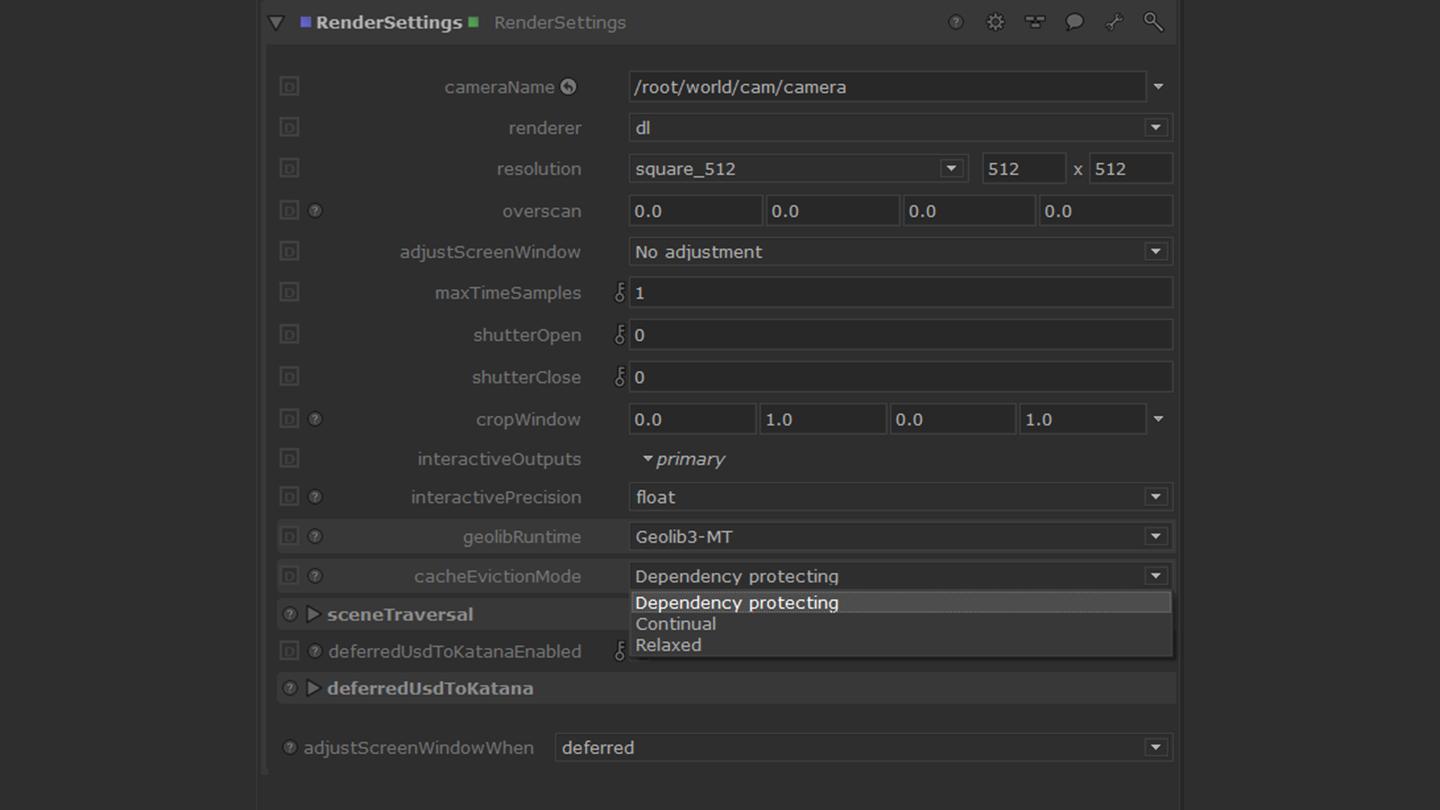
What's New
Explore the latest product releases and more from Foundry.
Product releases
Insights
Experience Katana
Get first-hand insight into how exactly Katana can fit into your pipeline.
Discover the creative capabilities of Katana with a free 30-day trial.
